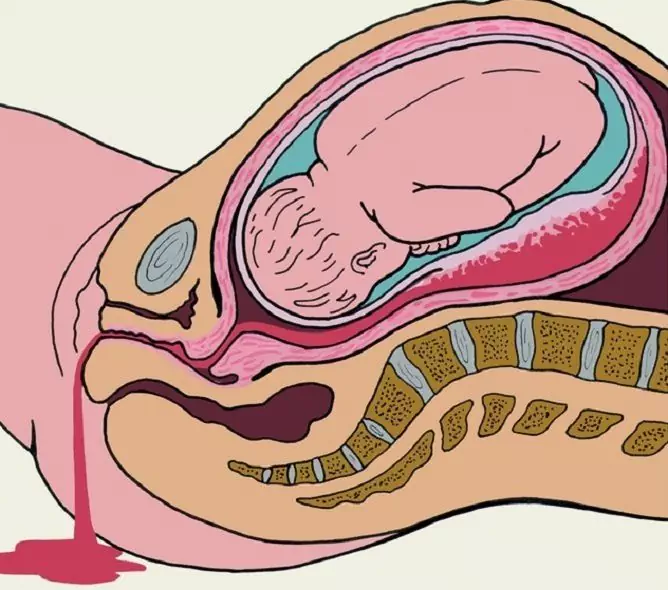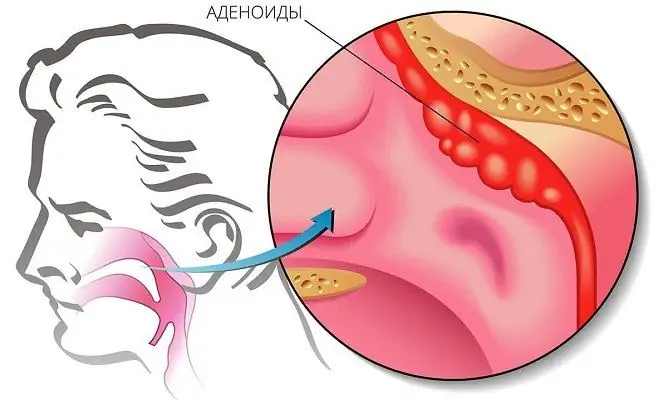- Author Rachel Wainwright [email protected].
- Public 2023-12-15 07:39.
- Last modified 2025-11-02 20:14.
Asthenia
The content of the article:
- Causes
- Kinds
- Asthenia symptoms
- Neurocirculatory asthenia
- Diagnostics
- Asthenia treatment
- Potential consequences and complications
- Forecast
- Prevention
Asthenia (asthenic syndrome) is a psychopathological syndrome that gradually develops against the background of severe diseases or other conditions, which is characterized by general weakness, lethargy or irritability, deterioration in physical and mental performance, sleep disorders, emotional lability, and autonomic disorders.

Constant fatigue is the main symptom of asthenia
Asthenia is the most common medical syndrome. In everyday practice, doctors of almost all specialties encounter him: therapists, infectious disease specialists, cardiologists, gastroenterologists, pediatricians, psychiatrists, traumatologists, and surgeons.
Asthenia can be a precursor symptom of an incipient disease, occur in its midst, or develop during convalescence.
Asthenia must be distinguished from normal fatigue. The latter arises as a result of non-observance of the regime of alternation of work and rest, change of climate or time zones, mental or physical overstrain. In case of usual fatigue after a good rest, the person's condition improves, working capacity is restored. Symptoms of asthenia are associated with a previous illness and develop gradually. Even a long rest does not lead to their disappearance, therefore, unable to cope on their own, patients are forced to seek medical help.
Causes
Asthenia develops against the background of many diseases and pathological conditions. Most often, the formation of this syndrome is observed in the following cases:
- infectious diseases (tuberculosis, viral hepatitis, foodborne diseases, ARVI);
- somatic diseases (neurocirculatory dystonia, glomerulonephritis, arterial hypertension, arrhythmia, pneumonia, enterocolitis, duodenal ulcer, acute and chronic gastritis);
- postoperative, post-traumatic or postpartum period;
- psychopathological conditions.

Asthenia can have different causes.
Most experts believe that the pathological mechanism for the development of asthenia is based on depletion of higher nervous activity associated with overstrain, and the immediate cause is metabolic disorders associated with excessive consumption of energy by the patient's body or insufficient intake of nutrients from outside.
Kinds
According to the etiological factor, asthenia is divided into organic and functional. Functional asthenia is observed in about 55% of cases and is a reversible temporary condition that develops as a reaction of the body to an acute illness, physical fatigue, and a stressful situation. Therefore, this type of asthenia is also called reactive.
The development of organic asthenia is associated with progressive organic pathology or somatic chronic diseases. Often this psychopathological syndrome is observed in patients suffering from diseases of the central nervous system:
- degenerative processes (senile chorea, Parkinson's disease, Alzheimer's disease);
- vascular disorders (ischemic and hemorrhagic stroke, chronic cerebral ischemia);
- demyelinating diseases (multiple sclerosis, multiple encephalomyelitis);
- severe traumatic brain injury;
- infectious organic diseases of the brain (tumor, abscess, encephalitis).

Asthenia classification
Also, taking into account the cause of development, post-infectious, postpartum, post-traumatic and somatogenic asthenia are distinguished.
According to the features of the clinical picture, asthenia is divided into two forms:
- Hypersthenic. It is characterized by severe irritability, due to which patients do not tolerate bright light, noise, any loud sounds.
- Hyposthenic. There is a decrease in susceptibility to any external stimuli, as a result of which the patient develops drowsiness, lethargy, and apathy.
The hypersthenic form is considered an easier variant of the course of asthenia. When the patient's condition worsens, it can be replaced by a hyposthenic form.
By the duration of the course, asthenia is divided into acute and chronic. Acute asthenia usually occurs after acute somatic diseases (gastritis, pyelonephritis, pneumonia, bronchitis), infectious diseases (dysentery, infectious mononucleosis, rubella, influenza, measles) or severe stress, that is, it is essentially functional.
Chronic asthenia is characterized by a long course. Most often it is organic in origin. A variant of chronic asthenia is chronic fatigue syndrome (burnout syndrome, manager syndrome).
As a separate form of asthenia, neurasthenia is considered, the development of which is due to a significant depletion of the central nervous activity.
Asthenia symptoms
Symptoms of asthenia in the morning hours are absent or very mild. But in the course of the day they gradually increase and reach their maximum in the evening. This becomes the reason that a person cannot finish work or household chores.
The most common symptom of asthenia is severe fatigue. When doing their usual things, patients get tired much faster than before, in addition, their working capacity is not fully restored even after a long rest. Fatigue in asthenia is manifested by unwillingness or inability to perform physical work due to severe weakness. Patients engaged in mental work complain that it has become difficult for them to concentrate their thoughts, focus on the task at hand, as well as a decrease in intelligence and attentiveness, difficulties in forming and verbally expressing their own thoughts. When doing their usual work, they are forced to systematically take short breaks, break the problem to be solved into small parts and solve each of them separately. However, this approach does not lead to an increase in working capacity,on the contrary, it further increases the feeling of fatigue. As a result, anxiety arises in the patient, anxiety grows, and self-doubt is formed.

A common symptom of asthenia is extreme fatigue.
Psychoemotional disorders are another symptom of asthenia. A decrease in working capacity inevitably leads to the appearance of problems in professional activity, and they, in turn, negatively affect the psychoemotional state of the patient. As a result, he becomes even more tense, irritable, quick-tempered, picky, quickly losing his composure. The mood changes rapidly (psychoemotional lability). In assessing what is happening, there are extremes (unreasonable optimism or pessimism). The progression of psychoemotional disorders can result in hypochondriacal or depressive neurosis, neurasthenia.
Asthenia is always accompanied by severe vegetative symptoms, the manifestations of which include:
- pain along the intestines;
- constipation;
- decreased appetite;
- generalized or localized hyperhidrosis;
- feeling of heat or, on the contrary, chilliness;
- drops in blood pressure;
- pulse lability;
- tachycardia.
With asthenia, complaints of a feeling of heaviness in the head or persistent headaches often occur. Decreased libido, men often have erectile dysfunction.

Persistent headaches often accompany asthenia
With a hypersthenic form of asthenia, it is difficult to fall asleep. Sleep becomes restless, accompanied by vivid disturbing dreams. Frequent nocturnal awakenings and early waking up are noted. Waking up in the morning, the patient does not feel completely rested, he remains weak, sleepy and weak, increasing during the day.
With the hyposthenic variant of asthenia, problems with falling asleep, poor quality of night sleep are also observed. But in the daytime, patients sometimes find it difficult to cope with drowsiness.
Neurocirculatory asthenia
Neurocirculatory asthenia (vegetative vascular dystonia) is a complex of symptoms caused by dysregulation of the functions of internal organs and systems by the vegetative part of the nervous system.
The diagnosis of neurocirculatory asthenia is made when the patient shows signs of dysfunction of the autonomic nervous system, but there are no organic diseases of the internal organs, neuroses or mental illnesses, the presence of which could explain the existing symptoms.
The development of neurocirculatory asthenia is most often caused by injuries of the spine and brain, stress, depression, changes in hormonal levels (pregnancy, menopause), metabolic diseases. A hereditary predisposition plays a certain role in the formation of pathology.
The clinical picture of neurocirculatory asthenia is highly variable. More than 150 symptoms have been described that can occur with this pathology. They are all combined into several syndromes:
- Cardialgic (cardiac). It is observed in more than 90% of patients. It is characterized by complaints of pain in the chest region and the left half of the chest, which can be of a different nature. The appearance of these pains is not associated with emotional stress, mental or physical stress, which distinguishes them from cardialgia, which occurs against the background of coronary heart disease.
- Sympathicotonic. It is characterized by tachycardia (over 90 beats per minute), periodic increase in blood pressure, motor agitation, pallor of the skin, headache, palpitations. Some patients may experience an increase in body temperature to subfebrile values.
- Vagotonic. It manifests itself as bradycardia (heart rate less than 60 beats per minute), often combined with extrasystole or other types of heart rhythm disturbances that are paroxysmal. Blood pressure is usually reduced to 90-80 / 60-50 mm Hg. Art. Patients complain of severe dizziness, headache, nausea, increased sweating, increased intestinal peristalsis, unstable stools.
- Mental. Complaints of fear, unmotivated mood swings, sleep disorders are characteristic. Some patients are sure that they suffer from an incurable, fatal disease.
- Asthenic. Its symptoms are: meteorological dependence, fatigue, general weakness.
- Respiratory. Complaints about shortness of breath, feeling of lack of air, inability to be in a stuffy room or travel in public transport in the warm season due to fear of suffocation.

Symptoms of vascular dystonia
In patients with neurocirculatory asthenia, two or more of the syndromes described above may be observed simultaneously. It is also interesting that the nature of complaints in many patients is constantly changing.
Diagnostics
Asthenia, which develops as the first symptom of a disease or is a consequence of an acute illness, injury or stress, usually has pronounced manifestations, so its diagnosis is not difficult.
If asthenia develops during the height of the underlying disease, against its background, its symptoms may be subtle. They can only be identified with a thorough analysis of the patient's complaints. During a conversation with a patient, special attention is paid to questions about the quality of sleep, mood, state of working capacity. Some patients with asthenia tend to exaggerate their complaints, while others, on the contrary, do not give them due importance. To obtain an objective picture, one should investigate the patient's mnestic sphere, assess the psychoemotional state, as well as the characteristics of the reaction to various external stimuli.
In some cases, asthenia must be differentiated from depressive neurosis, hypersomnia, hypochondriacal neurosis.

A comprehensive examination is needed to establish the cause of asthenia
An examination is carried out to determine the cause of the development of an asthenic state. For this, the patient is referred for consultation to narrow specialists (infectious disease specialist, endocrinologist, traumatologist, oncologist, phthisiatrician, nephrologist, pulmonologist, gynecologist, cardiologist, gastroenterologist). The following series of laboratory tests are performed:
- general analysis of urine and blood;
- biochemical blood test;
- coagulogram;
- coprogram.
If an infectious disease is suspected, PCR diagnostics or bacteriological examination of blood, urine, feces are performed in order to identify an infectious agent.
An instrumental examination of the patient is carried out, which, depending on the indications, may include:
- Ultrasound of the pelvic organs;
- Ultrasound of the abdominal organs;
- magnetic resonance imaging of the brain;
- Ultrasound of the kidneys;
- X-ray of the lungs (or fluorography);
- Ultrasound of the heart;
- electrocardiography;
- duodenal intubation;
- fibroesophagogastroduodenoscopy (FEGDS).
Asthenia treatment
Non-drug treatment for asthenia includes:
- a diet consistent with the underlying disease;
- recreational physical activity (walking, swimming, physiotherapy exercises);
- quitting smoking and drinking alcohol;
- observance of the optimal regime of alternation of work and rest.
A patient suffering from manifestations of asthenia is recommended, if possible, to change the environment and long-term good rest (tourist trip, spa treatment, vacation).
Proper nutrition is of no small importance. The diet should include foods rich in tryptophan (wholemeal bread, cheese, turkey meat, bananas), B vitamins (eggs, liver), as well as other vitamins and minerals (fresh juices, fruit and vegetable salads, apples, citrus fruits, strawberries, kiwi, sea buckthorn, black currant, rosehip infusion).
An important role in the therapy of asthenia is played by psychological comfort in the family and a calm atmosphere at work.

Patients with asthenia are advised to change the scene and go on vacation
Medication for asthenia mainly consists in taking adaptogens: pantocrine, eleutherococcus, Chinese magnolia vine, Rhodiola rosea, ginseng.
Currently, American specialists are treating asthenia with high doses of group B. But in other countries this technique has not become widespread, since its use is accompanied by a high risk of developing allergic reactions, including severe ones. Therefore, most experts prefer complex vitamin therapy, which includes not only B vitamins, but also PP, and ascorbic acid. In addition to them, the composition of complex multivitamin preparations must necessarily include trace elements necessary for the normal metabolism of vitamins (calcium, magnesium, zinc).
In the presence of indications in the complex therapy of asthenia, neuroprotectors and nootropics (hopantenic acid, Picamilon, Piracetam, Cinnarizin, gamma-aminobutyric acid, ginkgo biloba extract) are often used. However, it should be borne in mind that the effectiveness of these drugs for the treatment of asthenia is not confirmed by the results of scientific research.
Often, with asthenia, there is a need for therapy with psychotropic drugs (antidepressants, neuroleptics, tranquilizers), but they are used strictly as prescribed by a specialist - a psychiatrist or a neuropathologist.
Potential consequences and complications
A protracted course of asthenia can be complicated by the development of neurasthenia, hypochondriacal or depressive neurosis, depression.
Forecast
The effectiveness of the treatment of asthenia is largely determined by the success of the treatment of the underlying disease. If it is cured, then the symptoms of asthenia will quickly subside or disappear completely. The manifestations of chronic asthenia are also reduced to minimal severity in the event of a long-term remission of the underlying chronic disease.
Prevention
Prevention of asthenia is based on the prevention of the appearance of its causes. It includes measures aimed at increasing the body's resistance to the effects of negative environmental factors:
- rational and proper nutrition;
- rejection of bad habits;
- regular stay in the fresh air;
- moderate exercise;
- observance of the regime of work and rest.
In addition, it is necessary to timely identify and treat diseases that can lead to the development of asthenia.
YouTube video related to the article:

Elena Minkina Doctor anesthesiologist-resuscitator About the author
Education: graduated from the Tashkent State Medical Institute, specializing in general medicine in 1991. Repeatedly passed refresher courses.
Work experience: anesthesiologist-resuscitator of the city maternity complex, resuscitator of the hemodialysis department.
The information is generalized and provided for informational purposes only. At the first sign of illness, see your doctor. Self-medication is hazardous to health!






